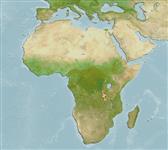Classification / Names
Common names | Synonyms | Catalog of Fishes (gen., sp.) | ITIS | CoL | WoRMS | Cloffa
Actinopterygii (ray-finned fishes) >
Siluriformes (Catfish) >
Mochokidae (Squeakers or upside-down catfishes)
Etymology: Synodontis: Greek, syn, symphysis = grown together + Greek, odous = teeth (Ref. 45335); grandiops: The specific name is a latinized combination of the Latin grandis, meaning large or big, and the Greek ops, meaning eye, a reference to the increased size of the eye of this species, particularly in relation to snout length (Ref. 59365).
Environment / Climate / Range
Ecology
Freshwater; demersal. Tropical, preferred ?
Africa: endemic to Lake Tanganyika, apparently common (Ref. 59365).
Size / Weight / Age
Maturity: Lm ? range ? - ? cm
Max length : 11.1 cm SL male/unsexed; (Ref. 59365)
Short description
Morphology | Morphometrics
Dorsal
spines
(total): 2;
Dorsal
soft rays
(total): 7;
Anal
spines: 3-4;
Anal
soft rays: 6 - 8;
Vertebrae: 34. Body is compressed laterally, with a convex predorsal profile, interrupted by a ridge formed by dorsal rim of eye; head somewhat depressed (Ref. 59365). Eye dorsolateral, ovoid, its diameter 64.2-81.0 % of snout length (Ref. 59365). Mandibular teeth 17-26, short and unicuspid, arranged in a single transverse row (Ref. 59365). Maxillary barbel without basal membrane, lacking branches or crenelations, and extending at least to base of pectoral fin; lateral mandibular barbel extending to point just short of anterior margin of pectoral girdle, with 4-5 non-tuberculate branches, lacking secondary branches; medial mandibular barbel 1/2 to 2/3 length of lateral barbel, with 4-5 pairs non-tuberculate branches, lacking secondary branches (Ref. 59365). Dorsal fin spine long, striated, nearly straight, terminating in short, white filament; anterior margin of fin spine with 0-3 small serrations distally; posterior margin with small serrations distally (Ref. 59365). Pectoral fin spine roughly equal in length to dorsal fin spine, striated, slightly curved, terminating in short, white filament; anterior spine margin with many small, antrorse serrations; posterior margin with large, retrorse serrations along entire length (Ref. 59365). Adipose fin short, poorly developed, margin convex (Ref. 59365). Body with large spots, fin spines brown to black (Ref. 59365).
Likely inhabits littoral to benthic zones over shell, sand and mud bottoms; no detailed information on diet exists, but species is likely to feed on small gastropods, as do other Synodontis species in Lake Tanganyika (Ref. 59365).
Life cycle and mating behavior
Maturity | Reproduction | Spawning | Eggs | Fecundity | Larvae
Wright, J.J. and L.M. Page, 2006. Taxonomic revision of Lake Tanganyikan Synodontis (Siluriformes: Mochokidae). Bull. Florida Mus. Nat Hist. 46(4):99-154. (Ref. 59365)
IUCN Red List Status (Ref. 115185)
CITES (Ref. 94142)
Not Evaluated
Threat to humans
Harmless
Human uses
Fisheries:
More information
Common namesSynonymsMetabolismPredatorsEcotoxicologyReproductionMaturitySpawningFecundityEggsEgg development
Age/SizeGrowthLength-weightLength-lengthLength-frequenciesMorphometricsMorphologyLarvaeLarval dynamicsRecruitmentAbundance
ReferencesAquacultureAquaculture profileStrainsGeneticsAllele frequenciesHeritabilityDiseasesProcessingMass conversion
Tools
Special reports
Download XML
Internet sources
